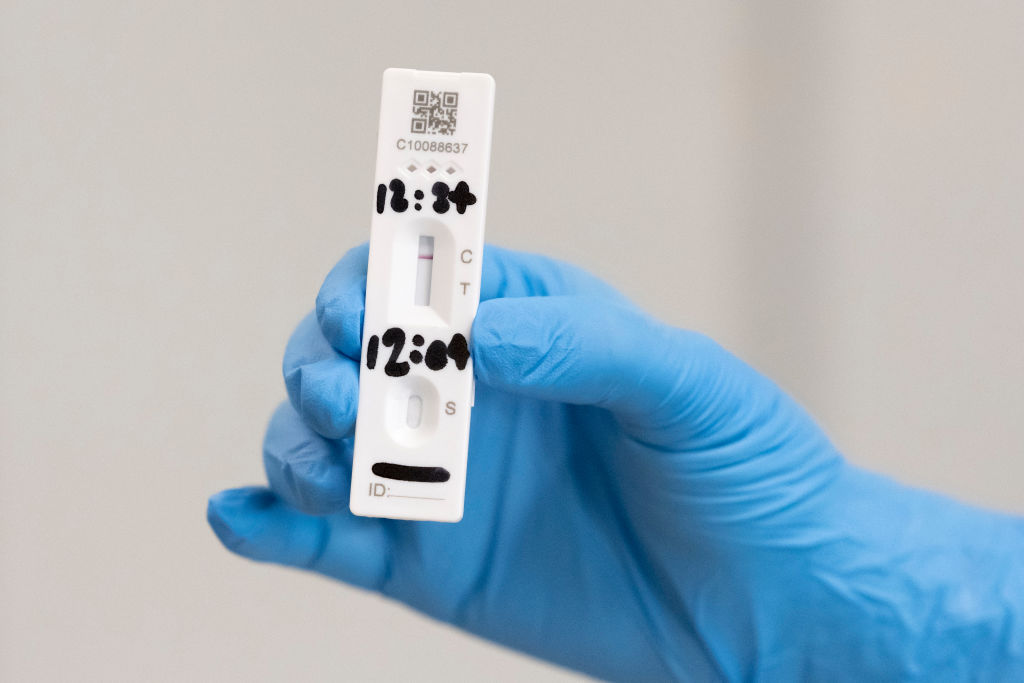This Wearable Sensor Detects COVID-19 Even WITHOUT Symptoms!
COVID-19 is tricky to be diagnosed because it has similar symptoms to other diseases.
Diagnosis of the disease is usually done through swab testing which includes a Q-tip-like material scraped on the noses. Imagine the pain it can cause the patient when the diagnostic test is administered.
Alongside the COVID-19 vaccine, the race is also the rise of researches anchored on different diagnostic tests that are sought to give a better and faster diagnosis to patients. Now, researchers from the University of California San Francisco (UCSF) and University of California San Diego (UCSD) invents a high-tech way of diagnosing patients if they have COVID-19.
ALSO READ: FDA Approves Becton Dickinson's 15-Minute Handheld Rapid COVID-19 Test
Wearable Sensor

A detail of a lateral flow test at Swansea University on December 8, 2020 in Swansea, Wales. Rapid coronavirus lateral flow tests are being offered to students ahead of the Christmas holiday. The Welsh Government has asked Wales universities to phase arrivals after Christmas with the return of students staggered over four weeks from January 11.
With the advancement of technology, UCSF and UCSD were able to discover an inventive way of finding out if a person is COVID-19 positive even with subtle manifestations of the disease.
According to UC San Francisco, the device or smart ring produces continuous temperature data that may foreshadow COVID-19, even in cases when the infection is not suspected. The researchers add that the device may be a better illness indicator than a thermometer can result in earlier isolation and testing, preventing the spread of infectious respiratory disease.
Resourcing Strategies adds that the health device monitors several signals including continuous temperature, heart rate, activity, and breathing rate. Eureka Alert furthers that the analysis of 50 people that are previously COVID-19 infected demonstrates that the data obtained from the commercially smart ring correctly identified higher temperatures in people with manifestations of COVID-19.
UCSF points out in their article that the authors mention 38 among the 50 participants, fever was detected when symptoms were unreported or even unnoticed. They also emphasize that the effectiveness of the wearable device on detecting asymptomatic COVID-19 is still unknown, which was reported by the Centers for Disease Control and Prevention (CDC) to affect 10 to 70 percent of the patients.
READ ALSO: Paper-Based Electrochemical Sensor: COVID-19 Detection in Less Than 5 Minutes
In detecting Illness with subtle manifestations
Eureka Alert notes that the researchers analyzed weeks of temperature data in determining typical ranges from 50 participants.
An assistant professor from the UC San Francisco Department of Psychiatry, principal investigator, and senior author, Ashley Mason, Ph.D., notes in a statement from UCSF that single-pointy temperature measurement is not very meaningful. She also emphasized in the statement that a temperature that is high for one person may not be a major irregularity for another person that is why continuous temperature information can identify a fever better.
In a report by UCSF, an assistant professor from the department of bioengineering and the HalicioÄŸlu Data Science Institute from UC San Diego, Benjamin Smarr, Ph.D. says that the question of how many asymptomatic cases are truly asymptomatic and how many might just be unnoticed or unreported. He adds that through the use of wearable technology, monitoring the body directly is made possible.
Resourcing Strategies adds that since the number of the study participants is small, the researchers made the ring accessible to nearly 3,400 healthcare workers from the United States and worked with Oura to invite existing users to participate in the study through the Oura app resulting in 65,000 participants worldwide.
The novelty of the device and its study demonstrates how effective the wearable device in detecting COVID-19.
READ NEXT: Simple, Routine Blood Test May Help Identify Mortality Risk Among COVID-19 Patients
Check out more news and information on COVID-19 and Medical Breakthrough on MD News Daily.
© MD News Daily.
